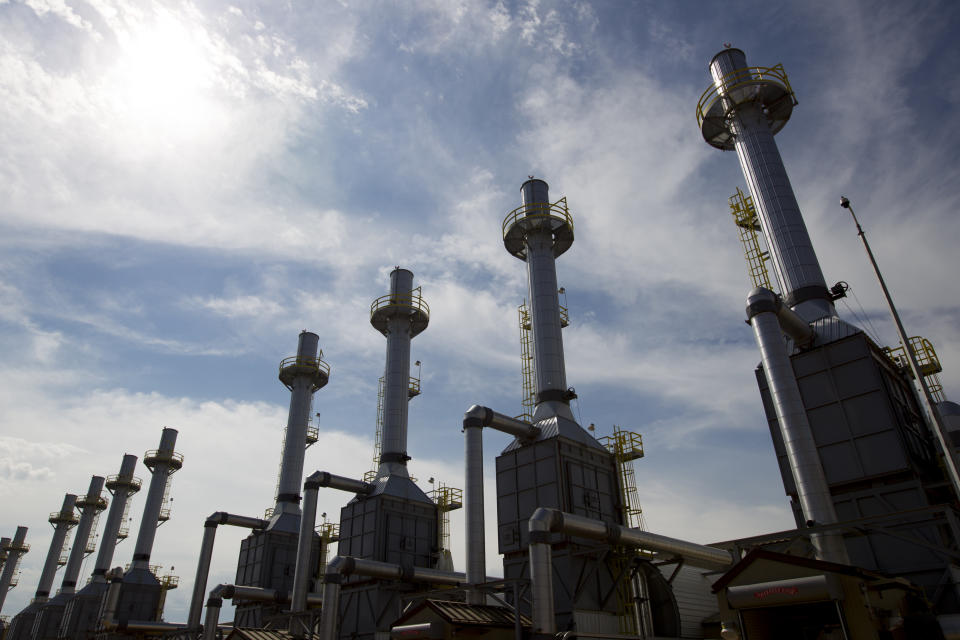America may be responsible for oil's plunging prices
Crude oil has had a crushing couple of weeks.
Domestic crude posted its twelfth consecutive day of losses on Tuesday, skidding for its longest losing streak on record. The U.S. benchmark settled firmly in bear market territory, down 27% after hitting four-year highs just weeks ago in early October. Prices for Brent crude have similarly tumbled from multi-year highs to bear market lows.
Analysts point to a web of interlocking factors for the price declines. Oil slipped in lock-step with the broader market sell-off in mid-October, and continued increases in production have renewed concerns of a price-depressing supply glut.
But according to some analysts, the single party responsible for the recent oil sell-off is staring Americans right in the face.
“The U.S. is likely responsible for much of the oversupply,” Citi analyst Edward Morse wrote in a note Wednesday. “It pressured the Kingdom and Russia to add more oil while promising the harshest oil sanctions on Iran ever applied, but actually (imposed) relatively light sanctions, exacerbating the oversupply.”
On November 5, the U.S. re-imposed sanctions on Iran’s critical energy sector, which had previously been lifted as part of the 2015 nuclear agreement. Oil prices rose at the end of August through the beginning of October in anticipation of the sanctions, even as Russia and Saudi Arabia – two of the biggest exporters – continued to increase output since the beginning of the year.
Concerns of the impact of Iran’s energy sanctions, however, were assuaged substantially after the U.S. announced it would be granting temporary waivers to eight nations, allowing them to continue importing Iranian oil.
“It’s occurring to the market with these waivers that were granted to eight Iranian buying markets that the impact of the sanctions are going to be much smaller than the market was betting on just two months ago,” Stephen Schork of the Schork report told Yahoo Finance last week.
President Donald Trump was quick to take credit for deflating oil prices in a press conference last week, citing the exemptions to Iranian oil exports.
“I gave some countries a break on the oil. I did it a little bit because they really asked for some help. But I really did it because I don’t want to drive oil prices up to $100 a barrel or $150 a barrel, because I’m driving them down,” Trump said. “You have a monopoly called ‘OPEC’ … and I don’t like that monopoly.”
Saudi Arabia and Russia have considered cutting output in the wake of declining prices, a move which Trump criticized in a Tweet on Monday. “Hopefully, Saudi Arabia and OPEC will not be cutting oil production. Oil prices should be much lower based on supply,” Trump wrote. Reuters reported Wednesday that Saudi Arabia and Russia are considering cuts of as many as 1.4 million barrels per day, higher than previously anticipated.
For Morse, Trump’s recent tweet about OPEC is “just one of many ‘made-in-Washington’ factors behind the recent record run of lower prompt prices.”

The U.S. is also to blame for the growing bearishness on oil demand, Morse added. Rhetoric focusing on the weakness of the Chinese economy and impacts of the trade war are feeding “into what now appears to be exaggerated concerns about demand growth in 2019 and beyond,” he said. This comes even as customs data last week showed that crude imports in China surged in October to a record 9.61 million barrels per day, from 9.05 million bpd in September.
“There are good chances that some of the trade-related fears won’t materialize,” Morse said.
The “final blow” for the U.S. impacting oil prices has been the “extraordinary momentum” of supply growth, Morse said. U.S. oil production has increased at an accelerating rate, hitting 11.6 million barrels per day earlier this month and catapulting the U.S. ahead of Saudi Arabia and Russia as the world’s largest oil producer.
Despite these factors, Morse believes prices will turn higher “long before” the end of the second quarter of 2019.
“Part of this is physical, and part is financial,” he said. “A cold winter snap or unplanned disruption in one of the ‘Fragile 5’ producers [Iraq, Venezuela, Nigeria, Algeria and Libya ] could quickly see bullish petroleum structures reemerge.”
Prices for the December 18 contract for US West Texas intermediate (CL=F) rebounded slightly Wednesday afternoon, climbing 1.76% to $56.67 per barrel as of 12:26 p.m. ET. Brent crude (BZ=F) prices rose 1.77% to $66.63 per barrel.
—
Emily McCormick is a reporter for Yahoo Finance. Follow her on Twitter: @emily_mcck
Follow Yahoo Finance on Twitter, Facebook, Instagram, Flipboard, LinkedIn, and reddit.
Read more from Emily:
Netflix user growth beats expectations, shares spike
Now is a ‘once-in-a-lifetime chance’ to invest in US pot companies, investor says
There are ‘4 headwinds’ facing markets rights now

 Yahoo Finance
Yahoo Finance 